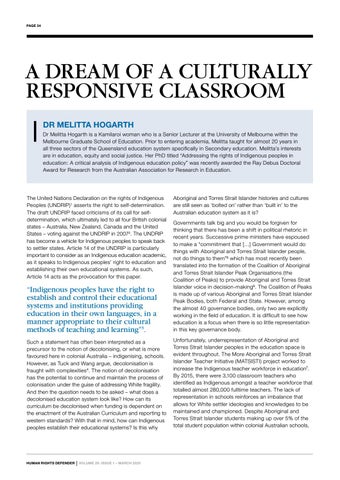PAGE 34
A DREAM OF A CULTURALLY RESPONSIVE CLASSROOM DR MELITTA HOGARTH Dr Melitta Hogarth is a Kamilaroi woman who is a Senior Lecturer at the University of Melbourne within the Melbourne Graduate School of Education. Prior to entering academia, Melitta taught for almost 20 years in all three sectors of the Queensland education system specifically in Secondary education. Melitta’s interests are in education, equity and social justice. Her PhD titled “Addressing the rights of Indigenous peoples in education: A critical analysis of Indigenous education policy” was recently awarded the Ray Debus Doctoral Award for Research from the Australian Association for Research in Education.
The United Nations Declaration on the rights of Indigenous Peoples (UNDRIP)1 asserts the right to self-determination. The draft UNDRIP faced criticisms of its call for selfdetermination, which ultimately led to all four British colonial states – Australia, New Zealand, Canada and the United States – voting against the UNDRIP in 20072. The UNDRIP has become a vehicle for Indigenous peoples to speak back to settler states. Article 14 of the UNDRIP is particularly important to consider as an Indigenous education academic, as it speaks to Indigenous peoples’ right to education and establishing their own educational systems. As such, Article 14 acts as the provocation for this paper.
Aboriginal and Torres Strait Islander histories and cultures are still seen as ‘bolted on’ rather than ‘built in’ to the Australian education system as it is?
“Indigenous peoples have the right to establish and control their educational systems and institutions providing education in their own languages, in a manner appropriate to their cultural methods of teaching and learning”3.
Governments talk big and you would be forgiven for thinking that there has been a shift in political rhetoric in recent years. Successive prime ministers have espoused to make a “commitment that […] Government would do things with Aboriginal and Torres Strait Islander people, not do things to them”5 which has most recently been translated into the formation of the Coalition of Aboriginal and Torres Strait Islander Peak Organisations (the Coalition of Peaks) to provide Aboriginal and Torres Strait Islander voice in decision-making 6. The Coalition of Peaks is made up of various Aboriginal and Torres Strait Islander Peak Bodies, both Federal and State. However, among the almost 40 governance bodies, only two are explicitly working in the field of education. It is difficult to see how education is a focus when there is so little representation in this key governance body.
Such a statement has often been interpreted as a precursor to the notion of decolonising, or what is more favoured here in colonial Australia – indigenising, schools. However, as Tuck and Wang argue, decolonisation is fraught with complexities 4. The notion of decolonisation has the potential to continue and maintain the process of colonisation under the guise of addressing White fragility. And then the question needs to be asked – what does a decolonised education system look like? How can its curriculum be decolonised when funding is dependent on the enactment of the Australian Curriculum and reporting to western standards? With that in mind, how can Indigenous peoples establish their educational systems? Is this why
Unfortunately, underrepresentation of Aboriginal and Torres Strait Islander peoples in the education space is evident throughout. The More Aboriginal and Torres Strait Islander Teacher Initiative (MATSISTI) project worked to increase the Indigenous teacher workforce in education7. By 2015, there were 3,100 classroom teachers who identified as Indigenous amongst a teacher workforce that totalled almost 280,000 fulltime teachers. The lack of representation in schools reinforces an imbalance that allows for White settler ideologies and knowledges to be maintained and championed. Despite Aboriginal and Torres Strait Islander students making up over 5% of the total student population within colonial Australian schools,
HUMAN RIGHTS DEFENDER | VOLUME 29: ISSUE 1 – MARCH 2020









